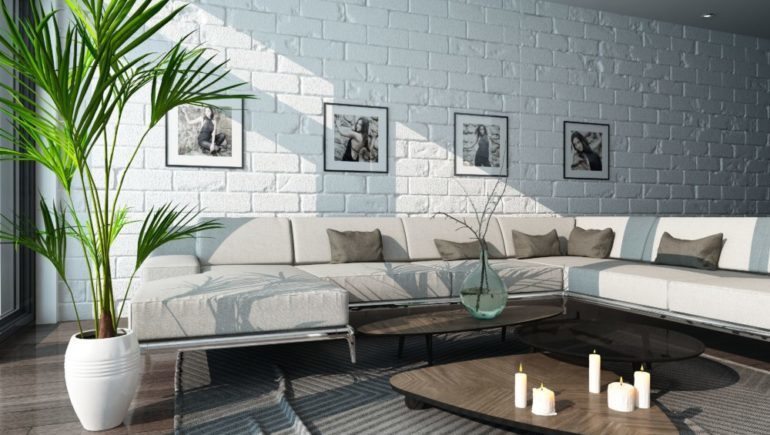Painted brick is an exciting new design trend. Is painting your tired brick exterior or that overly orange wall in the den a good way to rev up your decor? Let’s explore this option.
Pros and Cons of Painted Brick
Painted brick is one of the easiest, least expensive ways to update your home’s exterior or the features inside. The vanilla, yellow or orange-brown brick that was stylish in the 1960s can look tired and dated today. You can give your home’s exterior a fresher look by painting it a cool neutral, a clean white, a muted blue or another color that coordinates with your shutters, eaves, and front door. As style trends change in the future, simply repaint to change the color.
Painting brick requires effort but is a simple and inexpensive job compared to replacing the exterior brick. Inside the house, painted brick fireplaces, walls, and backsplashes add interesting texture to rooms. And painting brick allows you to coordinate these features with the rest of a room’s color scheme.
Removing paint from brick is a difficult, sometimes impossible task, so make sure you’re committed before you get out the ladder and paintbrushes. And keep in mind that painted brick exteriors will require more maintenance than unpainted.
Prep Work
Brick must be thoroughly cleaned before painting. You can clean exterior brick with a good power washing. Another option is scrubbing the brick with a stiff bristled brush. Use a mix of trisodium phosphate (TSP) and water or a mild bleach solution to kill mildew. Never use muriatic acid or another acid to clean the brick; it can mess up your paint job. Whether inside or outside, brick should be thoroughly rinsed after cleaning. Make sure the brick is completely dry before beginning to paint by waiting at least 24 hours after cleaning. It’s also important to repair small cracks in the brick’s mortar with acrylic caulk and allow it to thoroughly set before you paint.
Applying the Paint
The best base for paint is a latex primer. Allow the primer coat to dry completely before applying the actual paint. Acrylic latex paint works fine on brick, but elastodynamic paint is better at filling cracks and stands up well to damp weather. A semi-gloss finish provides an easy-to-clean look.
The size of the area you’re painting determines the best tool for applying paint. A brush or a roller with a long nap that penetrates indentations works best for small areas such as fireplace surrounds. The job will probably require two coats. For larger areas and more thorough coverage, a paint sprayer is preferable. Be sure to mask areas around the brick completely and use drop cloths on everything around you to prevent drifting spray from landing on areas you don’t want to paint.
Color Selection
For exteriors, muted tones are often the best color choices since they provide an understated look while blending with contrasting tones on areas such as shutters and doors. And you can never go wrong with white, the ultimate neutral tone. It gives a fresh, clean appearance, and adjoining elements can be painted any color. If your neighborhood has a homeowners’ association, be sure to check to see if you are permitted to paint your exterior brick and if so, what colors are allowed.
Related: Choosing the Best Paint Colors for Home Staging


